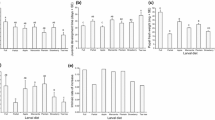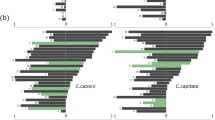Abstract
Herbivore diet breadth is predicted to evolve in response to both bottom-up and top-down selective pressures, including host plant abundance, quality and natural enemy pressure. As the relative importance and strength of interactions change over an herbivore’s geographic range, local patterns of host plant use should change in response, altering local diet breadths. Fall webworm (Hyphantria cunea) is a widespread, polyphagous moth species that feeds on hundreds of plant species worldwide. Populations of fall webworm in Colorado remain polyphagous, but their diet breadth is restricted compared to other populations and thus present an ideal opportunity to test the ecological drivers of host use by a polyphagous herbivore. We investigated how host abundance, larval performance, and parasitism affect host use for fall webworm to test how these selective pressures may act individually or in concert, as well as the role of any trade-offs among fitness components, to explain diet breadth and host use. We found that host abundance was a significant predictor of host use, which suggests a selective pressure to reduce search time for oviposition sites by adult females. We also detected an important trade-off between bottom-up and top-down selective pressures: higher quality host plants also had a greater proportion of larval mortality due to parasitism. Local patterns of host plant abundance appear to narrow the set of hosts used by fall webworms in Colorado, while the trade-off between host quality and risk of parasitism helps explain the maintenance of a generalized feeding strategy within this restricted set of hosts.




Similar content being viewed by others
References
Berger EW (1906) Observations upon the migrating, feeding, and nesting habits of the fall webworm (Hyphantria cunea Dru.). Bull Bureau Entomol USDA 80:41–65
Bernays E, Graham M (1988) On the evolution of host specificity in phytophagous arthropods. Ecology 69:886–892
Bernays EA, Minkenberg OPJM (1997) Insect herbivores: different reasons for being a generalist. Ecology 78:1157–1169
Calvo D, Molina JM (2005) Fecundity-body size relationship and other reproductive aspects of Streblote panda (Lepidoptera: Lasiocampidae). Ann Entomol Soc Am 98:191–196
Davis TS, Landolt PJ (2012) Body size phenotypes are heritable and mediate fecundity but not fitness in the lepidopteran frugivore Cydia pomonella. Naturwissenschaften 99:483–491
Ferguson DC, Opler PA, Smith MJ, Donahue JP (2000) Distribution of Arctiidae of Western North America. Moths of Western North America. C. P. Gillette Museum of Arthropod Diversity, Colorado State University, Fort Collins
Fox LR, Morrow PA (1981) Species property or local phenomenon? Science 211:887–893
Godfray HCJ (1994) Parasitoids, behavioral and evolutionary ecology. Princeton University Press, Princeton
Gomi T, Takeda M (1996) Changes in life-history traits in the fall webworm within half a century of introduction to Japan. Funct Ecol 10:384–389
Gotelli NJ, Ellison AM (2004) A primer of ecological statistics. Sinauer, Sunderland
Greenblatt JA (1978) Larval feeding preferences and inducibility in the fall webworm, Hyphantria cunea. Ann Entomol Soc Am 71:605–606
Gripenberg S, Mayhew PJ, Parnell M, Roslin T (2010) A meta-analysis of preference-performance relationships in phytophagous insects. Ecol Lett 13:383–393
Ito Y (1977) Birth and death. In: Hidaka T (ed) Adaptation and speciation in the fall webworm. Kodansha, Tokyo, pp 101–128
Jaenike J, Selander RK (1980) On the question of host races in the fall webworm, Hyphantria cunea. Entomol Exp Appl 27:31–37
Jasič J, Macko V (1961) Some results of experimental study of fall webworm (Hyphantria cunea Drury) (Lepidoptera: Arctiidae) ecology. Publishing Office of the Slovak Academy of Science, Bratislava
Jeffries MJ, Lawton JH (1984) Enemy free space and the structure of ecological communities. Biol J Linn Soc 23:269–285
Johansson J, Bergstrom A, Janz N (2007) The benefit of additional oviposition targets for a polyphagous butterfly. J Insect Sci 7:1–8
Karban R, Agrawal AA (2002) Herbivore offense. Annu Rev Ecol Syst 33:641–664
Karban R, Karban C, Huntzinger M, Pearse I, Crutsinger G (2010) Diet mixing enhances the performance of a generalist caterpillar, Platyprepia virginalis. Ecol Entomol 35:92–99
Lessells CM (1985) Parasitoid foraging: should parasitism be density dependent? J Anim Ecol 54:27–41
Loewy K et al (2013) Life history traits and rearing techniques for fall webworms (Hyphantria cunea Drury) in Colorado. J Lepidopt Soc 67:196–205
Masaki S, Ito Y (1977) Speciation. In: Hidaka T (ed) Adaptation and speciation in the fall webworm. Kodansha, Tokyo, pp 149–172
Mason PA, Wilkes SR, Lill JT, Singer MS (2011) Abundance trumps quality: bi-trophic performance and parasitism risk fail to explain host use in the fall webworm. Oikos 120:1509–1518
Mayhew PJ (1997) Adaptive patterns of host-plant selection by phytophagous insects. Oikos 79:417–428
Michaud JP (1990) Conditions for the evolution of polyphagy in herbivorous insects. Oikos 57:278–279
Mira A, Bernays EA (2002) Trade-offs in host use by Manduca sexta: plant characters vs. natural enemies. Oikos 97:387–397
Morris RF, Fulton WC (1970) Models for development and survival of Hyphantria cunea. Mem Entomol Soc Can 70:1–312
Murphy SM (2004) Enemy-free space maintains swallowtail butterfly host shift. Proc Natl Acad Sci 101:18048–18052
Murphy SM, Stoepler TM, Grenis K, Lill JT (2014) Host ontogeny determines parasitoid use of a forest caterpillar. Entomol Exp Appl 150:217–225
Oliver AD (1964) A behavioral study of two races of the fall webworm, Hyphantria cunea (Lepidoptera: Arctiidae) in Louisiana. Ann Entomol Soc Am 57:192–194
Price PW, Bouton CE, Gross P, McPheron BA, Thompson JN, Weis AE (1980) Interactions among three trophic levels: influence of plants on interactions between insect herbivores and natural enemies. Annu Rev Ecol Syst 11:41–65
Price PW, Denno RF, Eubanks MD, Finke DL, Kaplan I (2011) Insect ecology: behavior, populations and communities. Cambridge University Press, New York
Rehnberg BG (2002) Heat retention by webs of the fall webworm Hyphantria cunea (Lepidoptera: Arctiidae): infrared warming and forced convective cooling. J Therm Biol 27:525–530. doi:10.1016/s0306-4565(02)00026-8
Rodrigues D, Kaminski LA, Freitas AVL, Oliveira PS (2010) Trade-offs underlying polyphagy in a facultative ant-tended florivorous butterfly: the role of host plant quality and enemy free space. Oecologia 163:719–728
Schmid-Hempel P (2005) Evolutionary ecology of insect immune defenses. Annu Rev Entomol 50:529–551
Schoonhoven LM, Van Loon JJA, Dicke M (2005) Insect-plant biology, 2nd edn. Oxford University Press, Oxford
Singer MS (2008) Evolutionary ecology of polyphagy. In: Tilmon KJ (ed) Specialization, speciation, and radiation: the evolutionary biology of herbivorous insects. University of California Press, Oakland, pp 29–42
Singer MS, Rodrigues D, Stireman JO, Carriére Y (2004) Roles of food quality and enemy-free space in host use by a generalist insect herbivore. Ecology 85:2747–2753
Stoepler TM, Lill JT (2013) Direct and indirect effects of light environment generate ecological trade-offs in herbivore performance and parasitism. Ecology 94:2299–2310
Stoepler TM, Lill JT, Murphy SM (2011) Cascading effects of host size and host plant species on parasitoid resource allocation. Ecol Entomol 36:724–735
Swain RB (1936) The biological control of the fall webworm in Colorado. Master’s, Colorado State College, Fort Collins
Tadić MD (1963) Natural enemies of fall webworm (Hyphantria Cunea Dr.) in North America. Entomophaga 8:245–252
Thompson JN (1998) The evolution of diet breadth: monophagy and polyphagy in swallowtail butterfiles. J Evol Biol 11:563–578
Thompson JN (2005) The Geographic mosaic of coevolution. The University of Chicago Press, Chicago and London
Turlings TCJ, Tumlinson JH, Lewis WJ (1990) Exploitation of herbivore-induced plant odors by host-seeking parasitic wasps. Science 250:1251–1253
Waring RH, Coops NC, Fan W, Nightingale JM (2006) MODIS enhanced vegetation index predicts tree species richness across forested ecoregions in the contiguous U.S.A. Remote Sens Environ 103:218–226
Warren LO, Tadić M (1970) The fall webworm, Hyphantria cunea (Drury). Ark Exp Stn Bull 759:1–106
Yang Z, Wei J, Wang X (2006) Mass rearing and augmentative releases of the native parasitoid Chiuioia cunea for biological control of the introduced fall webworm Hyphantria cunea in China. Biocontrol 51:401–418
Yang ZQ, Wang XY, Wei JR, Qu HR, Qiao XR (2008) Survey of the native insect natural enemies of Hyphantria cunea (Drury) (Lepidoptera: Arctiidae) in China. Bull Entomol Res 98:293–302
Acknowledgments
We thank Amy Flansburg, Kylee Grenis, MacKenzie Kjeldgaard, Jennifer McCarty, Timothy McGowan, Lily Montesano, and Jennifer Vernick for their help in the field and/or lab as well as Martin Quigley for help with plant identification. We would like to thank Boulder County Open Space, City of Boulder Open Space and Mountain Parks, Fort Collins Natural Areas, and Jefferson County Open Space for granting research permits and their support of our research. We also thank the numerous homeowners who granted us access to their property. We thank members of the University of Denver organismal group, the plant-animal interactions group at the University of Colorado, Martin Quigley, Tom Quinn, Anna Sher, Teresa Stoepler, John Lill and two anonymous reviewers for helpful comments on earlier drafts of this manuscript that greatly improved its quality. This research was supported by the University of Denver through startup funds awarded to Shannon Murphy.
Author information
Authors and Affiliations
Corresponding author
Additional information
Communicated by Andreas Prinzing.
Electronic supplementary material
Below is the link to the electronic supplementary material.
Rights and permissions
About this article
Cite this article
Murphy, S.M., Loewy, K.J. Trade-offs in host choice of an herbivorous insect based on parasitism and larval performance. Oecologia 179, 741–751 (2015). https://doi.org/10.1007/s00442-015-3373-8
Received:
Accepted:
Published:
Issue Date:
DOI: https://doi.org/10.1007/s00442-015-3373-8




